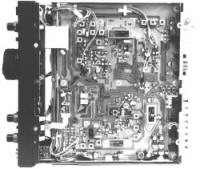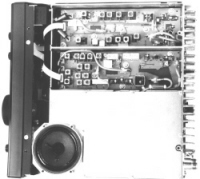
|
It's been several years now since a new VHF/UHF base station transceiver has appeared on the amateur market, and whilst attending Icom-UK's recent 'back to the future' product launch I was very excited to see the IC-820H 'in the flesh' for the first time. Being a keen VHF/UHF operator, I was even more pleased to be subsequently given this opportunity to test it for review in Ham Radio Today.
To mimic an oft-used TV marketing phase, the IC-820H really has been designed to be 'satellite ready', for use with the current generation of digital amateur satellites as well as the analogue 'trusty favourites'. It has ten tracking satellite memories, where the frequency on each band changes automatically in line with the satellite transponder you're working through, in either 'normal' or 'reverse' transponder modes. As well as allowing CW and SSB operation with the 'analogue birds', a 9600 baud packet data connection is fitted on the rear panel, the audio from this connecting to the TX modulator and RX demodulator stages as needed for high-speed packet operation on the 'main' band'.
The IC-820H is a compact set, measuring just 241mm (W) x 94mm (H) x 254mm (D) it certainly doesn't take up too much room on your shack table. Weighing just 5.2kg, you also won't run into a lot of problems in carrying it to and fro. Possibly the main reason for this is that it operates from an external 13.8V supply, which needs to provide up to around 16A for the |
IC-880H's high power output of 45W FM and 35W SSB on 2m, with 40W FM and 30W SSB on 70cm. A switchable low power setting of 6W is also available if you're 'mountain topping' with the set.
For DX and contest work, an IF shift control (often only found on HF rigs) helps out with adjacent-frequency QRM, and a switchable receive attenuator can be used in cases of receiver overload problems. You can even control optional Icom masthead-mounted 2m and 70cm preamplifiers from the set's front panel, and CW addicts will like to know there's an optional CW filter available. Finally, a switchable noise blanker is fitted as standard, in case you'd like to pop the set in your car for a spot of mobile operation, the transceiver indeed being small enough to do this.
The set comes supplied with a fist mic and DC lead as standard, and a matching mains power supply, the Icom PS-55, is available as an option. The IC-820H uses a Direct Digital Synthesizer to give a tuning resolution right down to 1Hz, a 'first' to my knowledge for any VHF/UHF multimode amateur rig. The transceiver covers 144-146 and 430-440MHz, with two digital 'VFOs' on each band, plus 100 fully-tuneable memories which can be allocated in 10 channel steps between the main and sub-bands. |
The 'main' band uses the larger of the two frequency displays together with the analogue S-meter, the sub-band having its own display with an independent bar-graph type S-meter. With a push of the 'sub' button, the main tuning knob can control either band, alternatively the RIT or IF Shift knob can be used if you wish for independent sub-band frequency change. An internal speaker provides combined audio from both bands, and by plugging in an external speaker or by using stereo headphones, the received audio from each band can be separated. Round the back of the set are a nice array of connectors, including separate aerial sockets for 2m and 70cm, linear amplifier switching including an ALC input for drive power control, and a C-IV socket for computer remote control. The 'packet' connection is selectable by using an internal switch between 'normal' packet operation (i.e. up to 4800 baud) with squelched receive audio and normal mic input level, which is the default setting 'as supplied', or 9600 baud with 1V p/p input and output levels which looks like it could be eminently suitable for connection to a G3RUH modem. The ALC connection is also internally switchable to a remote up/down input, for example for use automatic with Doppler shift correction of Low Earth Orbiting satellites from your PSK TNC.
The arrival of the review transceiver nicely coincided with the recently completed installation of my new Versatower, complete with yagis for 2m and 70cm (besides other bands). "What a good opportunity" I thought! A couple of few aerial switches allowed me to instantly compare the IC-820H with my usual HF rig and converter/transverter set-up for 2m and 70cm operation.
The first thing I found was that the IC-820H's receiver, especially on 2m, was sensitive, very sensitive, I was |
|
Operation
Although I've been quite used to operating a number of Icom rigs in the past, I found some of the operating functions on the IC-820H a little different than 'the norm'. However, after a good read of the instruction book and just a little practice, I quickly found the set to be quite versatile in terms of its operating modes. The 'check' facility was quite handy, this allowed me to quickly check my transmit frequency in 'split-frequency' operation, such as a repeater input when operating on FM. I did however feel a bit constrained at one of the front panel's 'dual-function' buttons. For example, the `PWR/Comp' button could either switch in the speech compressor, or switch to low power, depending upon how I'd initialised the set. I couldn't use low power (for correct satellite operation) as well as the speech compressor. However, apart from an internal low power level adjustment. I could control the output power by using an external 9V PP3 battery and a potentiometer connected to the ALC socket, although the 'dual function' of this connection meant I couldn't use the rear panel up/down switching for satellite frequency correction.
The transceiver had a useful 'set' mode for initialization, where I could cycle through individual 'menu' topics displayed on the main LCD, and customize the set's operation to suit me. Things such as frequency readout to 1Hz, RIT range, sub-dial tuning on/off, attenuator activation between bands, external preamp selection, sub-band audio mute during transmit, and the like, could be selected. I found it quite handy to have, effectively, two 'tuning dials', although the sub-band tuning was in the form of 'up/down' stepping depending on which way the smaller knob was moved. The up/down rate increased the further round the knob was moved, putting this back to the 'centre' position then halted the tuning.
On the air, the transceiver worked quite well on both bands, I managed to have several reasonably 'DX' contacts by taking advantage of the set's relatively high power and good receive sensitivity. Placing the speech processor in on SSB transmit however did bring up some distortion, although it certainly |
helped in cases of weak signal conditions at the 'far end'. On FM, the transmitted audio using the supplied fist microphone was described as very good, and I found the high power on FM allowed me to use quite distant repeaters that my 'normal' FM rig struggled with. The IC-820H has a 1750Hz toneburst fitted for repeater access, and an optional CTCSS unit can be fitted if required for repeater use or quiet monitoring. Note however this only operates in encode/decode mode when fitted in the UK IC-820H model, and not in encode-only mode. In satellite mode the set worked reasonably well also, although in this mode the sub band is always used for the receive side, so I couldn't take advantage of the IF shift nor the narrower CW bandwidth if I'd fitted the optional filter. Because the 9600 baud facility only operated on the main band, cross-band duplex 9600 baud satellite operation wasn't possible, although Icom-UK have informed me they can modify the set internally for this upon request. For highly-elliptic orbiting satellites at 'apogee', like Oscar-13, good receive sensitivity is a 'must'. By using the IC-820H, with a short feeder cable to my 2m beam, I could get away without using my masthead 2m preamp on the stronger downlink signals - good stuff!
Even with its light weight, the set comes in a well-built case with nicely 'screened' insides where needed, as you may see from the accompanying photos. The receiver uses a dual-conversion approach on both bands, with IFs of 10.85MHz (2m) and 71.25MHz (70cm) on the main band, and 10.95MHz (2m) and 71.35MHz (70cm) on the sub-band. As separate circuitry and filters are thus obviously used, I initially thought that the sub-band IF filtering would have been rather 'limited' when compared to that of the main receiver. Not so, as when subjected to the rigours of my signal generators and combiners, the performance seemed very similar, as you'll see from the measured figures!
The transmitter performed reasonably well 'on the bench' on both FM and SSB, although as I'd found on air, the SSB linearity degraded somewhat when I switched the speech processor in. The figures shown were those with it at the default 'factory setting', a small screwdriver-adjustable preset at the bottom of the transceiver adjusting this. |
Yes, reducing the level of compression did improve things, although the resultant 'talk power' was naturally somewhat lower. Conclusions
The IC-820H appears to 'break the bounds' in a high-performance VHF/UHF set capable of satellite operation in terms of its size and weight. It's eminently suitable for 'sticking in the car' and nipping up to the local hilltop for a spot of portable operation. I found the front panel controls, and the rear panel connectors, a little 'limited' where they 'doubled up' their use, one more knob and button would not have gone amiss in my opinion.
It performed very well on air, the receiver was extremely sensitive on 2m, which is especially good for DX and satellite work, whilst retaining good strong-signal handling performance. If you're a satellite buff, the IC-820H could be a serious contender for your station, but note that the IF shift or optional CW filters can't be used in this mode. Even so, I still wish I had one permanently in my station!
The IC-820H is currently priced at �1695, with the optional PS-55 mains supply at �245. My thanks go to Icom-UK for the loan of the review transceiver.  |